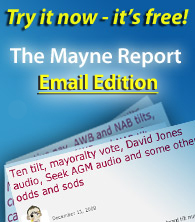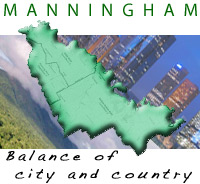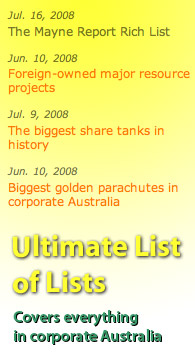Explaining the 2008 ASX board tilt
December 6, 2015
Stephen Mayne ran for the board of ASX at the AGM in Sydney on September 24, 2008. Here is an outline of the correspondence, key issues and various other links from the time.
The formalities
This consent to nominate letter was sent to ASX on August 4 and the company replied with a letter on August 16 agreeing to the nomination. The notice of meeting was released on August 24 and at least the ASX didn't choose to censor the platform, which reads as follows:
"Stephen Mayne, age 39. Bcom (Melb). Stephen Mayne is a Walkley Award winning business journalist and Australia's leading shareholder activist. He founded Australia's best known independent ezine www.crikey.com.au and now publishes the corporate governance ezine www.maynereport.com. Mr Mayne is standing on the single issue platform that ASX rescinds waivers granted to various Babcock & Brown and Macquarie Group listed vehicles that allow them to not fully disclose their management agreements for the likes of Macquarie Airports and Babcock & Brown Power. Once ASX forces this disclosure, and thereby takes the corporate governance and disclosure high road again, Mr Mayne will immediately resign. He has provided ASX with an undated letter of resignation conditional on the completion of such a disclosure process.
ASX responds with new Guidance Note
My philosophy has always been that you run to change things rather than to get elected and this looks a case in point because the ASX came out with this Guidance Note on August 28 which set down some new criteria for how listed funds with external managers have to behave.
The AFR's Chancticleer columnist Alan Jury suggested on September 3 that this made my candidacy "redundant", although Alan Kohler presented a different view on Business Spectator on September 4 when he declared: "Last week the ASX issued a guidance note on external management agreements which basically wimped out of a crackdown on them."
The early role of Risk Metrics
Risk Metrics is the world's biggest proxy advisory firm and it really blew the whistle on Australia's Wild West listed infrastructure fund model when it released this report in April exposing the appalling governance structures and ASX connivance in what Babcock and Macquarie introduced to our market.
The report was written by Martin Lawrence and Prof Geof Stapleton, who has since left to join BHP-Billiton in London. However, Lawrence has subsequently been prominent in the media with columns such as this one on Business Spectator, along with this appearance on Inside Business with Alan Kohler.
His boss, Dean Paatsch, also fronted The 7.30 Report after the Babcock & Brown profit announcement on August 23 and made these strong comments about ASX culpability:
With Babcock & Brown Power, in order to remove the manager, investors would have to pay 25 years worth of management fees to Babcock & Brown. And that's a ridiculous scenario. In my view, the ASX should share some of the blame for not informing investors adequately about the full consequences of these management agreements. We'd like to see that changed.
Risk Metrics ups the ante
Risk Metrics really set the cat among the pigeons with its 21-page report to institutional clients on September 9 spelling out in great detail how ASX Ltd has dropped the ball on corporate governance and now should be punished by investors with a protest vote against incumbent director Russell Aboud at the AGM on September 24.
Rather than tackling the detail of what the world's biggest and most powerful proxy advisory firm said, ASX could only hit back yesterday with this five paragraph press release. Mark Hawthorne summed up the thoughts of many in The Age on September 11:
The ASX had better come up with some better evidence that it is doing its job. The best it can muster is to restate ASIC's annual assessment of the ASX's compliance.
"For the sixth consecutive year, ASIC gave ASX a clean bill of supervisory health, concluding that ASX is adequately supervising the market, and managing any conflicts between its commercial and supervisory operations," the ASX declared yesterday.
Sadly, the sentiment about town is that perennially under-staffed and under-funded ASIC would struggle to catch a cold, let a alone a crook.
What about Trevor Rowe and CGI Glass Lewis?
Whilst targeting Aboud is controversial and many agree with John Durie in The Australian today that Trevor Rowe was the more suitable director on the ASX ballot to oppose, the bigger issue is that our monopoly stock exchange has blundered badly in recent times, damaging Australia's reputation by not upholding strong governance standards.
The AFR's influential Chanticleer columnist Alan Jury called the Risk Metrics approach "very worthwhile" in his September 11 column because of the debate it has triggered. Unfortunately, it appears that the other reputable proxy advisory firm CGI Glass Lewis has opposed my candidacy and endorsed the two incumbents, despite apparently having serious concerns about the ASX as well.
Why the ABC chairman should quit ASX now
Long-serving ASX chairman and current ABC chairman Maurice Newman, a close mate of John Howard, has been the biggest single contributor to the problem with Australia's highly conflicted monopoly exchange. He drove the demutualisation of the ASX in 1998 and then for a long time denied it had any regulatory role at all.
Whilst compulsory super combined with the great credit and financial engineers boom to deliver 300-fold returns for the 606 stockbroker members who retained their shares earned from the original $25,000 membership, Newman was also the chairman who progressively let standards slip. For instance, how on earth did AWB get to be listed in Australia when the owners of the company could only appoint 2 of the 12 directors?
AWB fundamentally offended the one vote one value principle, but Maurice Newman and the ASX were happy to help its mates in the government who got them rich through the demutualisation.
Whilst Newman's replacement David Gonski has issues with his tax haven advice to Westfield boss Frank Lowy, at least he is a relative ASX board clean skin who will be able to drive reform once the 70-year-old Newman retires after the ASX AGM.
I asked Gonski at the Westfield AGM earlier this year who would be chairing proceedings on September 24 and he wasn't sure. Given that it will be a contentious day, surely it is not appropriate for Maurice Newman to control the debate and then promptly resign. If all was happy in the markets, a swansong AGM farewell would have been fine, but we're now dealing with serious issues and it has been Gonski who has apparently been doing the rounds with institutional investors and corporate governance groups.
If Gonski is the man for the future he should be in charge of the AGM and it would be easier for all concerned if Newman retired the day before and didn't even attend.
The ASIC reports into ASX
Whilst the ASX has claimed a clean bill of health from ASIC each year, there are plenty of criticisms in the fine print, especially in the most recent version.
After all, you don't suddenly have the first broker fail to settle in 24 years and then declare everything is perfect. Check out the ASIC reports for yourself:
Latest report - July 2008
March 2006
July 2005
September 2004
First report - September 2003
In July 2004, ASIC and ASX signed this Memorandum of Understanding over market supervision, which clearly hasn't worked very well when you consider the lack of insider trading prosecutions and the bedlam of recent months.
And where has ASX been on director dealings? The whole issue was comprehensively explained by Greg Hoy in this story on The 7.30 Report a few months back.
Why hasn't Michael Sharpe resigned?
The AFR's gossip columnist Andrew White made some good points on September 11 about the whole Babcock & Brown disaster which is at the core of governance problems within our market now that the world regards these Bermuda-registered, over-geared, opaque, listed infrastructure vehicles as something akin to the Wild West. His column explained the issue as follows:
As Russell Aboud could be excused for thinking, a better target for Risk Metrics's wrath might have been fellow ASX director Michael Sharpe, who has served on the market supervision board. Until recently Sharpe was also a director of Babcock & Brown, chairing the audit and risk committee. Gripes about the ASX's soft touch to B&B make up the bulk of Risk Metrics reasons for going after the board. He resigned from B&B last month for health reasons, although they don't appear to have been so severe as to force him off the ASX board.
I've been raising concerns about Sharpe ever since hearing from a very good source that as chairman of the Babcock & Brown audit committee, he had been involved in decisions that led to PwC being appointed as auditor to various Babcock listed satellite. This is a terrible look given that Sharpe maintains an office at PwC.
PwC has pocketed many millions more from these appallingly governed Babcock vehicles than the ASX has collected in listing fees. And I reckon they haven't done a very good job either.
PwC audit partner Marc Upcroft signed off on the latest Babcock & Brown Power accounts, which claims it has net assets of $1.4 billion after the modest write-downs that led to the $426 million net loss for 2007-08. Given that the market values the whole business at $105 million, which is more than the $106 million in fees that Babcock & Brown ripped out in 2007-08, investors clearly disagree.
If you need a reminder about the scandal of Babcock & Brown Power with its still undisclosed and largely irrevocable 25 year management contract, check out Alan Kohler's strong column on Business Spectator in early September. How an ASX director can be associated with such a debacle is hard to comprehend.
Exposing ASX for its rorted election process
The Australian's John Durie ventillated the issue known as the "no vacancy rort" on September 11 when he wrote that "the vote at this (ASX) meeting seems rigged to block corporate gadfly Stephen Mayne from winning a seat".
The best way to demonstrate the rort is to look back at the voting results from my first tilt at the ASX board in 2000. It was statistically impossible to get elected because the ASX constitution gives the board the flexibility to pick any number to be the maximum, rather than allowing shareholders to decide.
This is how the voting unfolded in 2000:
Max Fowles: 95.34% of directed proxies in favour, rising to 96.6% after poll
Michael Sharpe: 96.44% of directed proxies in favour, rising to 97.45% after poll
Catherine Walter: 95.61% of directed proxies favour, rising to 96.84% after poll
Stephen Mayne: 13.55% of directed proxies in favour, falling to 8.85% after poll.
So why did the vote of the incumbents rise in the poll, whereas I plunged from 13.55% to 8.85%? It's called undirected or open proxies and these largely get accumulated by the chairman when shareholders just sign the form and send it back without ticking all the boxes.
There were only 11.53 million directed proxies on my candidacy, but chairman Maurice Newman still felt it necessary to smash me back into single digits by using the 5.168 million open proxies in the poll.
Whilst having 20.5% of the final votes on Cathy Walter's election and 29.1% of the final votes on mine sitting in his back pocket as open proxies was comforting for Maurice Newman, the killer blow comes when you combine this with what's called the "no vacancy rort".
You see, in 2000 the ASX board decided there was no room on the board for the challenger. It was four candidates for three spots, so I had to knock off one of the incumbents.
If you run the numbers again assuming I got 100% of the directed proxies in favour, I still would have lost badly because Maurice would have deployed the 5.1 million open proxies against me to drag the final poll result down to just 69%. He then would have declared the other three elected with their typical high 90s result.
If you read this letter nominating for the ASX board in 2008, I was very forthright in urging them not to do the "no vacancy rort" again, using the following language:
In the interests of running a fair election, I strongly urge ASX Ltd to follow the lead of Telstra and declare there is a vacancy for an additional director if 50% of the shares voted support such a move. The practice of declaring there is no vacancy normally makes it statistically impossible for an outsider to get elected, even with 100% of the directed proxies in favour. I will protest loudly and publicly if ASX goes down this road, like it did when I ran for the board in 2000, 2001 and 2002.
Lo and behold, they've done it again - three candidates for just two spots. A humble 50% majority is not good enough, I have to knock off one of the incumbents.
BHP-Billiton show ASX how to run a fair election
Compare the ASX tactic with BHP-Billiton, which replied to my recent board nomination with the following from company secretary Jane McAloon in a letter dated September 4:
We can confirm that the resolutions regarding your candidature will be put as separate resolutions and passed if more than 50% of the votes cast are in favour of your election.
If it's good enough for the biggest company listed on the ASX, then why can't the ASX itself run a fair election and acknowledge the very simple principle that board size is a matter for shareholders, the owners of the business. Sadly, Risk Metrics completely ignored this issue in its otherwise comprehensive report.
Canvassing for votes
It will be a very busy couple of week leading into the ASX AGM now that Risk Metrics have "lobbed a grenade" by recommending against Russell Oboud, as Stephen Bartholomeusz described it on Business Spectator.
I spent an hour in Sydney on September 10 looking through the list of ASX beneficial owners (after nominee companies have been stripped away) at the offices of Orient Capital. The time has come to start directly canvassing ASX shareholders to vote against the incumbents because that's the best way to put a rocket up the board on corporate governance.
And such a rocket would hopefully then lead to forced disclosure of all those Macquarie and Babcock management agreements. Unfortunately, this platform has been rejected by both the big proxy advisers, even though I tried to make it a safe protest by also providing an undated letter of resignation that would be triggered as soon as the disclosure requirement was satisfied.
Despite having simultaneous conversations with representatives from Risk Metrics and CGI Glass Lewis about this strategy at the ACSI corporate governance conference earlier in the year and receiving positive feedback, when it came to the crunch both groups have recommended against.
Russell Aboud should feel hard done by for being targeted when the simpler protest vote have been to vote for me, but Risk Metrics has instead picked a big fight with a largely innocent victim and it will be very interesting to see if its clients follow the recommendation.
Past experience has shown that institutions are happy to vote against pay resolutions, but they're reluctant to pick on individual directors when advised by the two proxy advisers. Come September 24 we'll know if things are different this time.
Audio of our disclosure battles with Babcock and Macquarie
I've been campaigning for many months now on the issue of third party infrastructure funds and the lack of disclosure of their management contracts. After being rejected by both Macquarie and Babcock, the only option left was to take the campaign direct to the ASX.
For instance, check out this package from the recent Macquarie Group AGM and listen to this audio exchange with chairman David Clarke and new CEO Nicholas Moore over the externally managed model.
Even more relevent was this exchange from the 2008 Babcock & Brown AGM on May 31 in Sydney where former CEO Phil Green was specifically asked about disclosure of management agreements and refused on spurious "intellectual property" grounds.
We even had Macquarie Airports chairman Max Moore-Wilton walk shareholders through the benefits of Bermuda after I pointed out all the governance downsides that came with the tax haven domicile.
Check out the full Macquarie Airports AGM coverage and listen to this specific battle over the structure and non-disclosure of the management contracts.
CGI skewers Newman over no vacancy rort
On the question of the no vacancy rort, CGI Glass Lewis was strong and attacked chairman Maurice Newman in its report to clients as follows:
Directors are the agents of and elected by shareholders to superintend the running of their company. Accordingly, we believe that shareholders should be able to appoint the number of directors they wish to represent their interests and that the board should, therefore, have enabled shareholders to elect all three candidates if that was their wish. Particularly having regard to the role of the ASX as regulator of other ASX listed entities, the ASX should itself exhibit the highest standards of corporate governance. We also note that the ASX board currently comprises ten persons, which does not appear to us to be overlarge. We believe that the board's shrinking of its size in the face of Mr Mayne's candidacy is not only a material breach of those standards and undemocratic but also sets a most regrettable precedent that other ASX listed entities can now with justification adopt. As current chairman and primary representative of shareholders, the outgoing Mr Newman must bear particular responsibility for this decision.
Given that this is the fourth time ASX has used this rort against me, surely that alone was enough to trigger a protest recommendation against the incumbents, or some more support for the outsider copping the rigged process
Risk Metrics was silent on this point, but gave ASX a much-deserved for failing in its governance work, as Terry McCrann so eloquently explained today.
The problem with Trevor Rowe
So why is nobody recommending against Trevor Rowe? Is he just too powerful to take on? Risk Metrics has previously humbled Telstra, News Corp, Rio Tinto and Macquarie Bank, so surely it could have taken on Rowe? The lad is certainly a master networker who also seems to have a blind spot for conflicts because he somehow chairs Queensland's sovereign fund, the QIC, whilst also sitting on the Future Fund board for the Commonwealth, giving him a hand in investing more than $110 billion of public funds.
Another big conflict was the way that QIC was the largest institutional backer of the disastrous Brisconnections float, which Rowe chairs.
Shares in this $1 float fell another 0.14c to a record low of 5.6c on Friday after Neil Chenoweth's fascinating front page story in The AFR suggesting that Macquarie could be on the hook for an exposure of up to $500 million in the teetering tollroad play.
BrisConnections has done some serious damage to the reputation of Trevor Rowe, but you wouldn't know it based on this interview he did with the KGB team at Business Spectator on September 12. It's a fascinating read with plenty of great detail about the infrastructure market and Rowe is certainly spruiking Brisconnections in a major way. Moreover listen to points about Brisconnections that I made to Mike Smith of 4BC Brisbane.
However, it was disappointing that neither Alan Kohler or Stephen Bartholomeusz raised the following key issues:
* Trevor Rowe is ridiculously overloaded with gigs and should step down from a couple.
* The conflicts surrounding QIC, BrisConnections, the Future Fund and the ASX.
* Whether Rowe thinks ASX has done a good job supervising the market and what he thinks about the attacks on its performance and the recommendation against Russell Aboud.
The Brisconnections float clearly should have been pulled, but Macquarie and Rowe soldiered on into a terrible market and now have egg all over their faces.
For mine, this fiasco warrants a vote against Rowe at the ASX AGM on September 24.
Who are the new ASX directors?
Maurice Newman: the retiring chairman is close mates with John Howard which explains how the original demutualisation got through in the first place and he also landed the gig of ABC chairman.
David Gonski: the incoming chairman is very smart and well-connected but has been damaged by recent revelations that he helped Frank Lowy put money through tax havens. We get on pretty well, as this account of the 2008 Westfield AGM demonstrates.
Russell Aboud: one of the two internal candidates up for re-election who, once again, comes from the issuer side of the fence after a career including heading Australasian and European equities for UBS, plus his current roles as chairman of Ord Minnett and a consultant to its parent, JP Morgan.
Shane Finemore: the son of trucker Ron Finemore he's a strange choice for this board given he's in his early 40s, is based in New York and just spent 6 years running UBS's troubled US fundamental investment business, after an earlier stint heading up Australasian equities, just like his ASX board colleague Russell Aboud.
Rick Holliday-Smith: did a good job as chairman of SFE Corp and deserves to be an ASX director given his relevent industry expertise in the futures markets.
Trevor Rowe: as the Macquarie-nominated chairman of BrisConnections he again demonstrates how the issuers dominate the ASX board although as a Future Fund guardian and QIC chairman, he nominally has substantial investor credentials as well, not to mention some conflicts of interest.
Jillian Segal: former Allens partner who rose to become deputy chairman of ASIC before becoming a professional director. Every board needs a good lawyer and given the ASIC relationship she is well suited for ASX.
Michael Sharpe: has suddenly quit the Babcock & Brown board due to ill-health but so far is fit and strong enough to continue serving as an ASX director. Strongly defended the Babcock governance low road on listed vehicles as this audio exchange from the 2008 AGM demonstrates. Time to go, but not up for election this year.
Peter Warne: as a Macquarie Group director, his presence on the ASX board just highlights how the issuers have captured our monopoly exchange when it should be investor representatives and good governance advocates calling the shots.
Relevent media reports
Peter Smith from The Financial Times picked up the Risk Metrics recommendation against ASX incumbent Russell Aboud.
News Ltd's Terry McCrann let fly at the ASX for being asleep whilst governance deteriorated across the market.
The Age's Malcolm Maiden believes the ASX is partly to blame for the current governance problems in the Australian market.
Tony Boyd revealed the scale of Babcock's looting of its funds with this piece on Business Spectator pointing to the $108 million in fees extracted from the power fund in 2007-08, which exceeds the current market value. Alan Kohler let fly with this spray in response.
The AFR's Chancticleer columnist produced this comment piece on September 3 suggesting my campaign was "redundant" because the ASX had responded with this Guidance Note supposedly toughening up the disclosure regime for third party management agreements. Unfortunately, ASX is yet to force Babcock & Macquarie to publish the full contracts so I disagree with this "redundant" line.
Stephen Bartholomeusz wrote this column on September 1 for Business Spectator about the way huge fees are still being extracted from the various Babcock funds, some of which are now up for sale. But how do you value them?
Fairfax's Michael West wrote this column on August 22 when Babcock released its results and axed its top two executives. West also went hard on July 23 when Macquarie Group held its AGM in Melbourne.
Mayne Report subscriber reports on ASX tilt
Here are the links to recent Mayne Report member updates which cover the ASX tilt:
Besieged Trevor Rowe calls in the KGB
September 12
ASX under the pump like never before
September 11
ASX shock and Kerry Stokes a no show
September 10
How Babcock scandal highlights ASX tilt rationale
September 4
Pressure mounting on ASX
September 3
ASX shows how not to do corporate elections
September 2
ASX responds and special end of season profit wrap
September 1, 2008
Record losses, ASX rorts, Lowy spray, Macquarie gouging and Babcock delusions
August 27, 2008
Babcock, Macquarie and James Hardie
August 20, 2008
Commander collapse, ASX tilt, activist funds and recent share trading
August 8, 2008
Stokes punting, ASX tilt and new ABC Learning board
August 5, 2008
Past ASX board tilts
I've run for the ASX board previously and here is a summary of what happened.
2000: opposed conflict of interest from being a for-profit regulator and got 13.52% of the vote - see package of highlights.
2001: once again opposed conflict of interest from being a for-profit regulator and got 10.69% of the vote - see Crikey report, read edited transcript and read student Danny Board's interesting account of what happened.
2002: despite not making the AGM in Sydney, won 18.7% of the vote. See results.
Copyright © 2024 The Mayne Report. All rights reserved






















